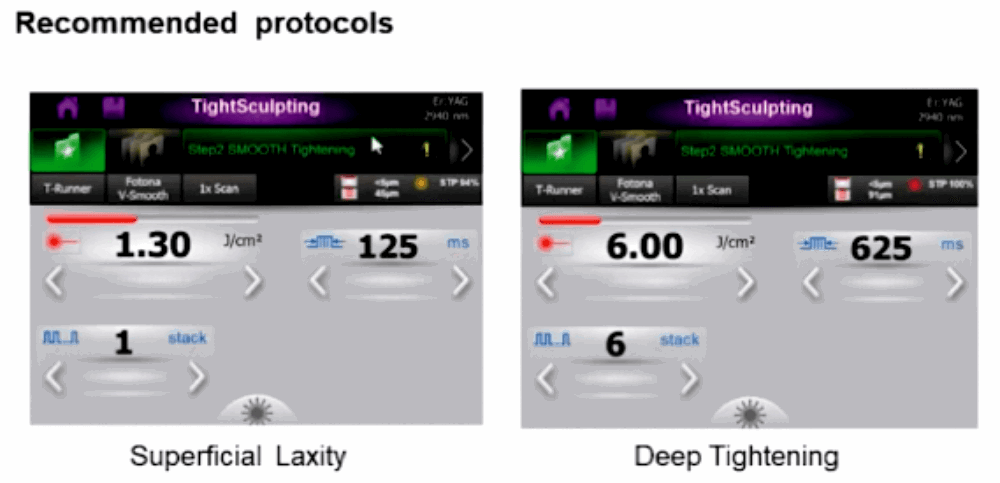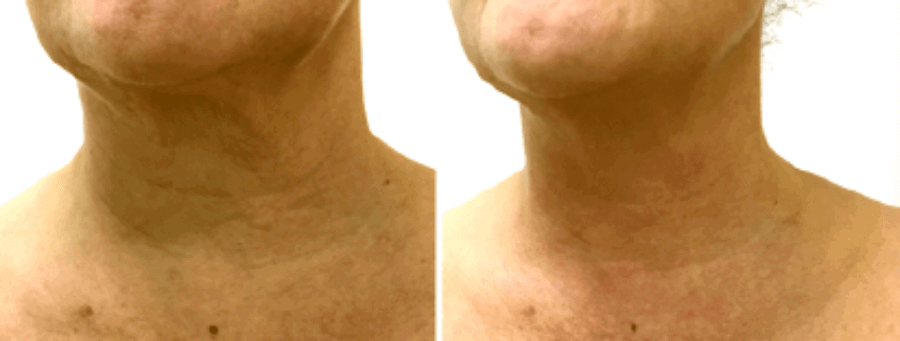Individuals with skin laxity and wrinkles around the neck area have, until recently, not had any successful non-invasive treatments available to improve this appearance of ageing around the neck area and upper chest. The Fotona SP Dynamis laser has a patented application that both promotes non-ablative neo-collagenesis as well as tightening of existing collagen fibres in the connective tissue of the dermis that results in visibly reduced laxity and wrinkles over this area.
Patient selection
Best results are obtained in patients between the ages of 25 to 65 years where the subdermal connective tissue still has potential for good collagen remodelling. All Fitzpatrick skin types are appropriate for treatment. Exclusion criteria found in the medical history or current medication usage are the same as for any Erbium laser treatment.
Treatment
As with all laser treatments, advice on avoiding sun exposure should be followed. Patients should be counselled to reduce exposure to high levels of UVA / UVB and should apply an SPF 50 for two weeks prior to treatment over the area being treated due to the increased stimulation of melanin by the sun. Treatment should be delayed for at least two weeks if patients are going on holiday to a sunny climate to allow melanin levels to reduce.
The laser treatment utilises Erbium-Yag as the energy source, which has a high affinity to water, so best results are achieved if tissue hydration is optimised both pre-treatment and post-treatment. Patients are therefore advised to keep their skin well hydrated using a moisturiser.
Treatment uses the patented Smooth Mode Erbium-Yag technology, and the author would recommend using the T-runner handpiece, which allows quick, safe and consistent delivery of laser energy to the skin and subdermal tissues. The scanner monitors and allows control of the penetration depth, the energy used, the pulse duration, in addition to the number of stacks of energy in each area.
The surface temperature parameter (STP) can be adjusted by changing any of the three variables depending on the individual patient’s response. It is an extremely comfortable treatment with minimal surface heat for patients when the STP is kept at <100%. Some examples of treatment parameters are outlined in Figure 1. These variables can be adjusted to suit the individual patient.

Figure 1: Recommended Protocols.
A treatment session is approximately 45 minutes with the exact duration of treatment being dependent on the practitioner’s assessment of the skin and how many combinations of laxity need addressing from superficial to deep.
Generally, three to four treatments, which are spaced three to six weeks apart, are required for patients depending on the desired end result. They may require an additional ‘top up’ treatment after 12 to 18 months to maintain the results.
Patients should continue to keep their skin well moisturised. They should also continue to apply a good factor 50 SPF for at least two weeks following treatment. It is recommended to avoid a hot sunny holiday / climate for at least two weeks post treatment.
Results
Patients are usually able to see an immediate visible improvement in their neck laxity at the first session, and will continue to see improvements in their skin and the tightening of their tissues for several months after treatment (Figure 2).

Figure 2: Pre-treatment image (left) and post-treatment image (right).
Conclusion
From the patient’s perspective we have found this treatment has high levels of satisfaction. Results are noticed with an immediate effect. Longer lasting effects will become apparent from four weeks onwards and continue for months after treatment. The treatment is well tolerated, comfortable and safe for the patient.
From the practitioner’s perspective, treatment using the scanner is consistent and replicable. It is ergonomically superior than a simple handpiece and allows adjustment of all parameters reflected in the STP which gives a clear level of the patient’s comfort levels and allows the practitioner to tailor the treatment to the individual.
Declaration of competing interests: The author is a UK Fotona Laser Trainer.
COMMENTS ARE WELCOME





